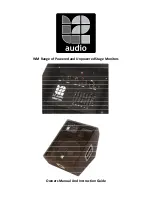
INTRODUCTION
This manual is designed to help you get the most from your L2 audio WM/WMP series stage
monitor. The WM range refers to passive or unpowered stage monitors. These monitors require
an external amplification source. The WMP range refers to active or powered monitors. These
monitors are self powered so only require a signal source.
There are 2 models in each range, 10” and 12”. Both models feature 2 way speaker
configurations, a low frequency (LF) woofer and a high frequency (HF) compression driver. The
woofer has been carefully selected for optimum performance and the basket is constructed from
steel. The HF is a titanium diaphragm and a light mass voice coil, enabling it to reach frequencies
as high as 20KHz. There is a quality crossover unit built in that separates the high and low
frequencies.
Both ranges of monitors have a 35mm top hat to enable mounting onto a speaker stand. You will
notice that the WM stage monitors are designed to enable you to use 2 different angles. The
popular angle is the one that has the most surface area of the monitor on the stage. If you need a
longer throw, then the monitor can be used ‘sitting up’ at a sharper angle. Remember that you
can link many powered monitors together to be placed in various positions on the stage. If you
have purchased a WMP/WM pair, you cannot link in another WM. If you have purchased WM
series monitors, you are able to run up to 4 from a L2 audio PA series power amplifier (2 off each
channel, linking through). If you have 2 WMP series monitors and 2 auxiliaries on your mixer, you
can have 2 separate monitor mixes from your desk.
Connections On Your WMP Series Stage Monitors
1.
Input
on the WMP10H is via ¼” jack. This should be a quality screened signal lead from the
auxiliary or monitor output of your mixer.
2. Output
or link out is for connectivity to another powered monitor and should be linked
with a quality screened ¼”jack signal lead.
3. Volume
. To increase or decrease the volume of the signal in.


























